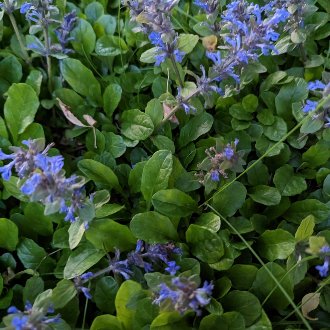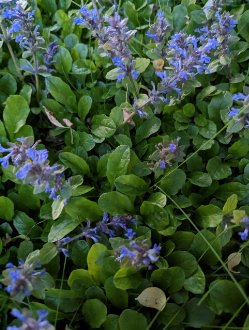Bugleweed (Ajuga reptans L.)
Also known as bugle, bugleherb, blue bugel, bugleweed, carpetweed, carpet bugleweed, carpet bugle, common bugle, St. Lawrence plant.
↑Range - Expand
| Legend | Color |
| Introduced | |
| Introduced or Not Present |
This tentative map is based on our own research. It may have limited data on Canada and/or Mexico, and there is some subjectivity in our assignment of plants as introduced vs. expanded. Read more in this blog post.
Although this plant occurs somewhere in each of these regions, it may only occur in a small part of some or all of them.
↑Habitat
The habitat preferences of this species are not well-described, and we have seen examples of this species thriving in conditions broader than those discussed in the literature. This species may be in the process of adapting to new habitats in North America and it has likely not yet invaded all possible habitats where it could survive. In North America, it is most often found in degraded habitats in urban or suburban areas.
It seems to prefer partial sun. In its native range it is found in openings or edges in deciduous forest, thickets, and meadows. In North America it is most common in wild areas of gardens, suburban parks, and edges or openings in small forest fragments. It prefers mesic to slightly moist conditions and is tolerant of a slight degree of poor drainage but not soil that is frequently waterlogged. It prefers loamy soil but can tolerate clayey or sandy soils to a degree. It prefers acidic soil but has a fairly broad range of pH tolerance.
↑Life Cycle
Bugleweed is a mat-forming perennial that reproduces primarily vegetatively, but also reproduces by seed.
↑Control
This species is relatively easy to remove from a site, but, because rosettes are inconspicuous and because this species is widely planted in gardens, removal is often limited by people's ability to locate and identify all plants, and/or convince landowners with robust source populations to remove this plant.
Unfortunately, nurseries are still selling this plant and people are still planting and actively cultivating it in gardens. The most important aspect of control is to stop people from actively cultivating this plant.
Small infestations are easily controlled by hand-digging individual plants; control can be carried out at any time of year when the ground is not frozen. Large monocultures can be sprayed with herbicides, which readily kill this plant, but since this plant often grows in moist areas, care must be taken to avoid spraying formulations with strong surfactants where such chemicals may be harmful to aquatic life.
Control is most difficult on sites where there is little competing native vegetation, such as small wild habitat fragments in urban or suburban areas.
↑Links & External Resources
• Ajuga reptans (Carpet Bugle) | Illinois Wildflowers (About This Site)
• Ajuga reptans (common bugle) | USDA PLANTS Database (About This Site)
• Ajuga reptans | Go Botany (About This Site)
• Ajuga reptans (Common Bugle) | Missouri Botanical Garden Plant Finder (About This Site)
• Ajuga reptans | Biota of North America Project (BONAP) (About This Site)
• Ajuga reptans | NatureServe Explorer (About This Site)
• Ajuga reptans | Missouri Plants (About This Site)
• Common Bugle | Maryland Biodiversity Project (About This Site)
• Ajuga reptans L. (Carpet-bugle) | Digital Atlas of the Virginia Flora (About This Site)




